Weightlessness
Weightlessness is the complete or near-complete absence of the sensation of weight. This is also termed zero-G, although the more correct term is "zero G-force". It occurs in the absence of any contact forces upon objects including the human body.
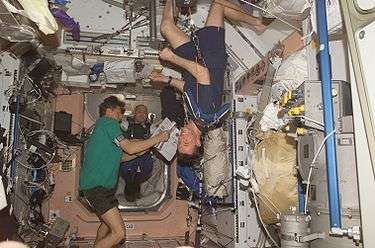
Weight is a measurement of the force on an object at rest in a relatively strong gravitational field (such as on the surface of the Earth). These weight-sensations originate from contact with supporting floors, seats, beds, scales, and the like. A sensation of weight is also produced, even when the gravitational field is zero, when contact forces act upon and overcome a body's inertia by mechanical, non-gravitational forces- such as in a centrifuge, a rotating space station, or within an accelerating vehicle.
When the gravitational field is non-uniform, a body in free fall experiences tidal effects and is not stress-free. Near a black hole, such tidal effects can be very strong. In the case of the Earth, the effects are minor, especially on objects of relatively small dimensions (such as the human body or a spacecraft) and the overall sensation of weightlessness in these cases is preserved. This condition is known as microgravity, and it prevails in orbiting spacecraft.
Weightlessness in Newtonian mechanics
In Newtonian mechanics the term "weight" is given two distinct interpretations by engineers.
- Weight1: Under this interpretation, the "weight" of a body is the gravitational force exerted on the body and this is the notion of weight that prevails in engineering. Near the surface of the earth, a body whose mass is 1 kg (2.2 lb) has a weight of approximately 9.81 N (2.21 lbf), independent of its state of motion, free fall, or not. Weightlessness in this sense can be achieved by removing the body far away from the source of gravity. It can also be attained by placing the body at a neutral point between two gravitating masses.
- Weight2: Weight can also be interpreted as that quantity which is measured when one uses scales. What is being measured there is the force exerted by the body on the scales. In a standard weighing operation, the body being weighed is in a state of equilibrium as a result of a force exerted on it by the weighing machine cancelling the gravitational field. By Newton's 3rd law, there is an equal and opposite force exerted by the body on the machine. This force is called weight2. The force is not gravitational. Typically, it is a contact force and not uniform across the mass of the body. If the body is placed on the scales in a lift (an elevator) in free fall in pure uniform gravity, the scale would read zero, and the body said to be weightless i.e. its weight2 = 0. This describes the condition in which the body is stress free and undeformed. This is the weightlessness in free fall in a uniform gravitational field. (The situation is more complicated when the gravitational field is not uniform, or, when a body is subject to multiple forces which may, for instance, cancel each other and produce a state of stress albeit weight2 being zero. See below.)
To sum up, we have two notions of weight of which weight1 is dominant. Yet 'weightlessness' is typically exemplified not by absence of weight1 but by the absence of stress associated with weight2. This is the intended sense of weightlessness in what follows below.
A body is stress free, exerts zero weight2, when the only force acting on it is weight1 as when in free fall in a uniform gravitational field. Without subscripts, one ends up with the odd-sounding conclusion that a body is weightless when the only force acting on it is its weight.
The apocryphal apple that fell on Newton's head can be used to illustrate the issues involved. An apple weighs approximately 1 newton (0.22 lbf). This is the weight1 of the apple and is considered to be a constant even while it is falling. During that fall, its weight2 however is zero: ignoring air resistance, the apple is stress free. When it hits Newton, the sensation felt by Newton would depend upon the height from which the apple falls and weight2 of the apple at the moment of impact may be many times greater than 1 N (0.22 lbf). It is this weight2 which distorts the apple. On its way down, the apple in its free fall does not suffer any distortion as the gravitational field is uniform.
Stress during free fall
- In a uniform gravitational field: Consider any cross-section dividing the body into two parts. Both parts have the same acceleration and the force exerted on each is supplied by the external source of the field. There is no force exerted by one part on the other. Stress at the cross-section is zero. Weight2 is zero.
- In a non-uniform gravitational field: Under gravity alone, one part of the body may have a different acceleration from another part. This would tend to deform the body and generate internal stresses if the body resists deformation. Weight2 is not 0.
Throughout this discussion on using stress as an indicator of weight, any pre-stress which may exist within a body caused by a force exerted on one part by another is not relevant. The only relevant stresses are those generated by external forces applied to the body.
The definition and use of 'weightlessness' is difficult unless it is understood that the sensation of "weight" in everyday terrestrial experience results not from gravitation acting alone (which is not felt), but instead by the mechanical forces that resist gravity. An object in a straight free fall, or in a more complex inertial trajectory of free fall (such as within a reduced gravity aircraft or inside a space station), all experience weightlessness, since they do not experience the mechanical forces that cause the sensation of weight.
Force fields other than gravity
As noted above, weightlessness occurs when
- no resultant force acts on the object
- uniform gravity acts solely by itself.
For the sake of completeness, a 3rd minor possibility has to be added. This is that a body may be subject to a field which is not gravitational but such that the force on the object is uniformly distributed across the object's mass. An electrically charged body, uniformly charged, in a uniform electric field is a possible example. Electric charge here replaces the usual gravitational charge. Such a body would then be stress free and be classed as weightless. Various types of levitation may fall into this category, at least approximately.
Weightlessness and proper acceleration
A body in free fall (which by definition entails no aerodynamic forces) near the surface of the earth has an acceleration approximately equal to 9.8 m/s2 (32 ft/s2) with respect to a coordinate frame tied to the earth. If the body is in a freely falling lift and subject to no pushes or pulls from the lift or its contents, the acceleration with respect to the lift would be zero. If on the other hand, the body is subject to forces exerted by other bodies within the lift, it will have an acceleration with respect to the freely falling lift. This acceleration which is not due to gravity is called "proper acceleration". On this approach, weightlessness holds when proper acceleration is zero.
Ways to avoid weightlessness
Weightlessness is in contrast with current human experiences in which a non-uniform force is acting, such as:
- standing on the ground, sitting in a chair on the ground, etc., where gravity is countered by the support force of the ground,
- flying in a plane, where a support force is transmitted from the lift the wings provide (special trajectories which form an exception are described below),
- during atmospheric reentry, or during the use of a parachute, when atmospheric drag decelerates a vehicle,
- during an orbital maneuver in a spacecraft, or during the launch phase, when rocket engines provide thrust.
In cases where an object is not weightless, as in the above examples, a force acts non-uniformly on the object in question. Aero-dynamic lift, drag, and thrust are all non-uniform forces (they are applied at a point or surface, rather than acting on the entire mass of an object), and thus create the phenomenon of weight. This non-uniform force may also be transmitted to an object at the point of contact with a second object, such as the contact between the surface of the Earth and one's feet, or between a parachute harness and one's body.
Tidal forces
Tidal forces arise when the gravitational field is not uniform and gravitation gradients exist. Such indeed is the norm and strictly speaking any object of finite size even in free-fall is subject to tidal effects. These are impossible to remove by inertial motion, except at one single nominated point of the body. The Earth is in free fall but the presence of tides indicates that it is in a non-uniform gravitational field. This non-uniformity is more due to the moon than the sun. The total gravitational field due to the sun is much stronger than that of the moon but it has a minor tidal effect compared with that of the moon because of the relative distances involved. Weight1 of the earth is essentially due to the sun's gravity. But its state of stress and deformation, represented by the tides, is more due to non uniformity in the gravitational field of the nearby moon. When the size of a region being considered is small relative to its distance from the gravitating mass the assumption of uniform gravitational field holds to a good approximation. Thus a person is small relative to the radius of Earth and the field for a person at the surface of the earth is approximately uniform. The field is strictly not uniform and is responsible for the phenomenon of microgravity. Objects near a black hole are subject to a highly non-uniform gravitational field.
Frames of reference
In all inertial reference frames, while weightlessness is experienced, Newton's first law of motion is obeyed locally within the frame. Inside the frame (for example, inside an orbiting ship or free-falling elevator), unforced objects keep their velocity relative to the frame. Objects not in contact with other objects "float" freely. If the inertial trajectory is influenced by gravity, the reference frame will be an accelerated frame as seen from a position outside the gravitational attraction, and (seen from far away) the objects in the frame (elevator, etc.) will appear to be under the influence of a force (the so-called force of gravity). As noted, objects subject solely to gravity do not feel its effects. Weightlessness can thus be realised for short periods of time in an airplane following a specific elliptic flight path, often mistakenly called a parabolic flight. It is simulated poorly, with many differences, in neutral buoyancy conditions, such as immersion in a tank of water.
Zero-g, "zero gravity", accelerometers
Zero-g is an alternative term for weightlessness and holds for instance in a freely falling lift. Zero-g is subtly different from the complete absence of gravity, something which is impossible due to the presence of gravity everywhere in the universe. "Zero-gravity" may also be used to mean effective weightlessness, neglecting tidal effects. Microgravity (or µg) is used to refer to situations that are substantially weightless but where g-force stresses within objects due to tidal effects, as discussed above, are around a millionth of that at the Earth's surface. Accelerometers can only detect g-force i.e. weight2 (= mass × proper acceleration). They cannot detect the acceleration associated with free fall.[lower-alpha 1]
Sensation of weight
Humans experience their own body weight as a result of this supporting force, which results in a normal force applied to a person by the surface of a supporting object, on which the person is standing or sitting. In the absence of this force, a person would be in free-fall, and would experience weightlessness. It is the transmission of this reaction force through the human body, and the resultant compression and tension of the body's tissues, that results in the sensation of weight.
Because of the distribution of mass throughout a person's body, the magnitude of the reaction force varies between a person's feet and head. At any horizontal cross-section of a person's body (as with any column), the size of the compressive force being resisted by the tissues below the cross-section is equal to the weight of the portion of the body above the cross-section. In the pose adopted in the accompanying illustration, the shoulders carry the weight of the outstretched arms and are subject to a considerable torque.
A common misconception
A common conception about spacecraft orbiting the earth is that they are operating in a gravity free environment. Although there is a way of making sense of this within the physics of Einstein's general relativity, within Newtonian physics, this is technically inaccurate .
Spacecraft are held in orbit by the gravity of the planet which they are orbiting. In Newtonian physics, the sensation of weightlessness experienced by astronauts is not the result of there being zero gravitational acceleration (as seen from the Earth), but of there being no g-force that an astronaut can feel because of the free-fall condition, and also there being zero difference between the acceleration of the spacecraft and the acceleration of the astronaut. Space journalist James Oberg explains the phenomenon this way:[1]
The myth that satellites remain in orbit because they have "escaped Earth's gravity" is perpetuated further (and falsely) by almost universal misuse of the word "zero gravity" to describe the free-falling conditions aboard orbiting space vehicles. Of course, this isn't true; gravity still exists in space. It keeps satellites from flying straight off into interstellar emptiness. What's missing is "weight", the resistance of gravitational attraction by an anchored structure or a counterforce. Satellites stay in space because of their tremendous horizontal speed, which allows them—while being unavoidably pulled toward Earth by gravity—to fall "over the horizon." The ground's curved withdrawal along the Earth's round surface offsets the satellites' fall toward the ground. Speed, not position or lack of gravity, keeps satellites in orbit around the earth.
A geostationary satellite is of special interest in this context. Unlike other objects in the sky which rise and set, an object in a geostationary orbit appears motionless in the sky, apparently defying gravity. In fact, it is in a circular equatorial orbit with a period of one day.
Relativity
To a modern physicist working with Einstein's general theory of relativity, the situation is even more complicated than is suggested above. Einstein's theory suggests that it actually is valid to consider that objects in inertial motion (such as falling in an elevator, or in a parabola in an airplane, or orbiting a planet) can indeed be considered to experience a local loss of the gravitational field in their rest frame. Thus, in the point of view (or frame) of the astronaut or orbiting ship, there actually is nearly-zero proper acceleration (the acceleration felt locally), just as would be the case far out in space, away from any mass. It is thus valid to consider that most of the gravitational field in such situations is actually absent from the point of view of the falling observer, just as the colloquial view suggests (see equivalence principle for a fuller explanation of this point). However, this loss of gravity for the falling or orbiting observer, in Einstein's theory, is due to the falling motion itself, and (again as in Newton's theory) not due to increased distance from the Earth. However, the gravity nevertheless is considered to be absent. In fact, Einstein's realization that a pure gravitational interaction cannot be felt, if all other forces are removed, was the key insight to leading him to the view that the gravitational "force" can in some ways be viewed as non-existent. Rather, objects tend to follow geodesic paths in curved space-time, and this is "explained" as a force, by "Newtonian" observers who assume that space-time is "flat," and thus do not have a reason for curved paths (i.e., the "falling motion" of an object near a gravitational source).
In the theory of general relativity, the only gravity which remains for the observer following a falling path or "inertial" path near a gravitating body, is that which is due to non-uniformities which remain in the gravitational field, even for the falling observer. This non-uniformity, which is a simple tidal effect in Newtonian dynamics, constitutes the "microgravity" which is felt by all spacially-extended objects falling in any natural gravitational field that originates from a compact mass. The reason for these tidal effects is that such a field will have its origin in a centralized place (the compact mass), and thus will diverge, and vary slightly in strength, according to distance from the mass. It will thus vary across the width of the falling or orbiting object. Thus, the term "microgravity," an overly technical term from the Newtonian view, is a valid and descriptive term in the general relativistic (Einsteinian) view.
Microgravity
The term micro-g environment (also µg, often referred to by the term microgravity) is more or less a synonym of weightlessness and zero-G, but indicates that g-forces are not quite zero, just very small.
Weightless and reduced weight environments
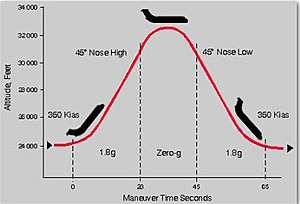
Reduced weight in aircraft
Airplanes have been used since 1959 to provide a nearly weightless environment in which to train astronauts, conduct research, and film motion pictures. Such aircraft are commonly referred by the nickname "Vomit Comet".
To create a weightless environment, the airplane flies in a six-mile long parabolic arc, first climbing, then entering a powered dive. During the arc, the propulsion and steering of the aircraft are controlled such that the drag (air resistance) on the plane is cancelled out, leaving the plane to behave as it would if it were free-falling in a vacuum. During this period, the plane's occupants experience 22 seconds of weightlessness, before experiencing about 22 seconds of 1.8 g acceleration (nearly twice their normal weight) during the pull-out from the parabola. A typical flight lasts around two hours, during which 30 parabolae are flown.

NASA's Reduced Gravity Aircraft
Versions of such airplanes have been operated by NASA's Reduced Gravity Research Program since 1973, where the unofficial nickname originated.[2] NASA later adopted the official nickname 'Weightless Wonder' for publication.[3] NASA's current Reduced Gravity Aircraft, "Weightless Wonder VI", a McDonnell Douglas C-9, is based at Ellington Field (KEFD), near Lyndon B. Johnson Space Center.
NASA's Microgravity University - Reduced Gravity Flight Opportunities Plan, also known as the Reduced Gravity Student Flight Opportunities Program, allows teams of undergraduates to submit a microgravity experiment proposal. If selected, the teams design and implement their experiment, and students are invited to fly on NASA's Vomit Comet.
European Space Agency A310 Zero-G
The European Space Agency flies parabolic flights on a specially-modified Airbus A310-300 aircraft,[4] in order to perform research in microgravity. As well European ESA, French CNES and German DLR fly campaigns of three flights on consecutive days, each flying about 30 parabolas, for a total of about 10 minutes of weightlessness per flight. These campaigns are currently operated from Bordeaux - Mérignac Airport in France by the company Novespace,[5] a subsidiary of French CNES, while the aircraft is flown by test pilots from DGA Essais en Vol. The first ESA Zero-G flights were in 1984, using a NASA KC-135 aircraft in Houston, Texas. As of May 2010, the ESA has flown 52 campaigns and also 9 student parabolic flight campaigns.[6]
Other aircraft it has used include the Russian Ilyushin Il-76 MDK before founding Novespace, and using then a French Caravelle, then an Airbus A300 Zero-G and now an Airbus A310 [7][8][9]
Commercial flights for public passengers
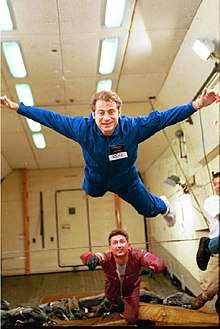
Novespace created Air Zero G in 2012 to share the experience of weightlessness to 40 public passengers per flight, using the same A310 ZERO-G than for scientific experiences.[10] These flights are sold by Avico, are mainly operated from Bordeaux-Merignac, France, and intend to promote European space research, allowing public passengers to feel weightlessness. Jean-François Clervoy, Chairman of Novespace and ESA astronaut, flies with Air Zero G one-day-astronauts on board A310 Zero-G. After the flight, he explains the quest of space and talks about the 3 space travels he did along his career. The aircraft has also been used for cinema purposes, with Tom Cruise and Annabelle Wallis for the Mummy in 2017.[11]
The Zero Gravity Corporation, founded in 1993 by Peter Diamandis, Byron Lichtenberg, and Ray Cronise, operates a modified Boeing 727 which flies parabolic arcs to create 25–30 seconds of weightlessness. Flights may be purchased for both tourism and research purposes.
Ground-based drop facilities
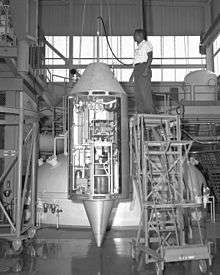
Ground-based facilities that produce weightless conditions for research purposes are typically referred to as drop tubes or drop towers.
NASA's Zero Gravity Research Facility, located at the Glenn Research Center in Cleveland, Ohio, is a 145-meter vertical shaft, largely below the ground, with an integral vacuum drop chamber, in which an experiment vehicle can have a free fall for a duration of 5.18 seconds, falling a distance of 132 meters. The experiment vehicle is stopped in approximately 4.5 meters of pellets of expanded polystyrene and experiences a peak deceleration rate of 65g.
Also at NASA Glenn is the 2.2 Second Drop Tower, which has a drop distance of 24.1 meters. Experiments are dropped in a drag shield, in order to reduce the effects of air drag. The entire package is stopped in a 3.3 meter tall air bag, at a peak deceleration rate of approximately 20g. While the Zero Gravity Facility conducts one or two drops per day, the 2.2 Second Drop Tower can conduct up to twelve drops per day.
NASA's Marshall Space Flight Center hosts another drop tube facility that is 105 meters tall and provides a 4.6 second free fall under near-vacuum conditions.[12]
Humans cannot utilize these gravity shafts, as the deceleration experienced by the drop chamber would likely kill or seriously injure anyone using them; 20g is about the highest deceleration that a fit and healthy human can withstand momentarily without sustaining injury.
Other drop facilities worldwide include:
- Micro-Gravity Laboratory of Japan (MGLAB) – 4.5 s free fall
- Experimental drop tube of the metallurgy department of Grenoble – 3.1 s free fall
- Fallturm Bremen University of Bremen in Bremen – 4.74 s free fall
- Queensland University of Technology Drop Tower - 2.0 s free fall
Neutral buoyancy
Conditions similar to some in weightlessness can also be simulated by creating the condition of neutral buoyancy, in which human subjects and equipment are placed in a water environment and weighted or buoyed until they hover in place. NASA uses neutral buoyancy to prepare for extra-vehicular activity (EVA) at its Neutral Buoyancy Laboratory. Neutral buoyancy is also used for EVA research at the University of Maryland's Space Systems Laboratory, which operates the only neutral buoyancy tank at a college or university.
Neutral buoyancy is not identical to weightlessness. Gravity still acts on all objects in a neutral buoyancy tank; thus, astronauts in neutral buoyancy training still feel their full body weight within their spacesuits, although the weight is well-distributed, similar to force on a human body in a water bed, or when simply floating in water. The suit and astronaut together are under no net force, as for any object that is floating, or supported in water, such as a scuba diver at neutral buoyancy. Water also produces drag, which is not present in vacuum.
Weightlessness in a spacecraft
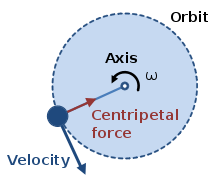
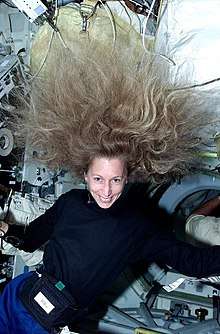
Long periods of weightlessness occur on spacecraft outside a planet's atmosphere, provided no propulsion is applied and the vehicle is not rotating. Weightlessness does not occur when a spacecraft is firing its engines or when re-entering the atmosphere, even if the resultant acceleration is constant. The thrust provided by the engines acts at the surface of the rocket nozzle rather than acting uniformly on the spacecraft, and is transmitted through the structure of the spacecraft via compressive and tensile forces to the objects or people inside.
Weightlessness in an orbiting spacecraft is physically identical to free-fall, with the difference that gravitational acceleration causes a net change in the direction, rather than the magnitude, of the spacecraft's velocity. This is because the acceleration vector is perpendicular to the velocity vector.
In typical free-fall, the acceleration of gravity acts along the direction of an object's velocity, linearly increasing its speed as it falls toward the Earth, or slowing it down if it is moving away from the Earth. In the case of an orbiting spacecraft, which has a velocity vector largely perpendicular to the force of gravity, gravitational acceleration does not produce a net change in the object's speed, but instead acts centripetally, to constantly "turn" the spacecraft's velocity as it moves around the Earth. Because the acceleration vector turns along with the velocity vector, they remain perpendicular to each other. Without this change in the direction of its velocity vector, the spacecraft would move in a straight line, leaving the Earth altogether.
Weightlessness at the center of a planet
The net gravitational force due to a spherically symmetrical planet is zero at the center. This is clear because of symmetry, and also from Newton's shell theorem which states that the net gravitational force due to a spherically symmetric shell, e.g., a hollow ball, is zero anywhere inside the hollow space. Thus the material at the center is weightless.
Human health effects
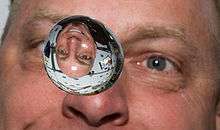
Following the advent of space stations that can be inhabited for long periods, exposure to weightlessness has been demonstrated to have some deleterious effects on human health.[13] Humans are well-adapted to the physical conditions at the surface of the Earth. In response to an extended period of weightlessness, various physiological systems begin to change and atrophy. Though these changes are usually temporary, long term health issues can result.
The most common problem experienced by humans in the initial hours of weightlessness is known as space adaptation syndrome or SAS, commonly referred to as space sickness. Symptoms of SAS include nausea and vomiting, vertigo, headaches, lethargy, and overall malaise.[14] The first case of SAS was reported by cosmonaut Gherman Titov in 1961. Since then, roughly 45% of all people who have flown in space have suffered from this condition. The duration of space sickness varies, but in no case has it lasted for more than 72 hours, after which the body adjusts to the new environment. NASA jokingly measures SAS using the "Garn scale", named for United States Senator Jake Garn, whose SAS during STS-51-D was the worst on record. Accordingly, one "Garn" is equivalent to the most severe possible case of SAS.[15]
The most significant adverse effects of long-term weightlessness are muscle atrophy (see Reduced muscle mass, strength and performance in space for more information) and deterioration of the skeleton, or spaceflight osteopenia.[14] These effects can be minimized through a regimen of exercise,[16] such as cycling for example. Astronauts subject to long periods of weightlessness wear pants with elastic bands attached between waistband and cuffs to compress the leg bones and reduce osteopenia.[17] Other significant effects include fluid redistribution (causing the "moon-face" appearance typical of pictures of astronauts in weightlessness),[17][18] a slowing of the cardiovascular system as blood flow decreases in response to a lack of gravity,[19] a decreased production of red blood cells, balance disorders, and a weakening of the immune system. Lesser symptoms include loss of body mass, nasal congestion, sleep disturbance, excess flatulence, and puffiness of the face. These effects begin to reverse quickly upon return to the Earth.
In addition, after long space flight missions, astronauts may experience severe eyesight problems.[20][21][22][23][24] Such eyesight problems may be a major concern for future deep space flight missions, including a manned mission to the planet Mars.[20][21][22][23][25] Exposure to high levels of radiation may influence the development of atherosclerosis also.[26]
On December 31, 2012, a NASA-supported study reported that manned spaceflight may harm the brains of astronauts and accelerate the onset of Alzheimer's disease.[27][28][29] In October 2015, the NASA Office of Inspector General issued a health hazards report related to human spaceflight, including a human mission to Mars.[30][31]
Effects on non-human organisms
Russian scientists have observed differences between cockroaches conceived in space and their terrestrial counterparts. The space-conceived cockroaches grew more quickly, and also grew up to be faster and tougher.[32]
Chicken eggs that are put in microgravity two days after fertilization appear not to develop properly, whereas eggs put in microgravity more than a week after fertilization develop normally.[33]
A 2006 Space Shuttle experiment found that Salmonella typhimurium, a bacterium that can cause food poisoning, became more virulent when cultivated in space.[34] On April 29, 2013, scientists in Rensselaer Polytechnic Institute, funded by NASA, reported that, during spaceflight on the International Space Station, microbes seem to adapt to the space environment in ways "not observed on Earth" and in ways that "can lead to increases in growth and virulence".[35]
Under certain test conditions, microbes have been observed to thrive in the near-weightlessness of space[36] and to survive in the vacuum of outer space.[37][38]
Technical adaptation in zero gravity
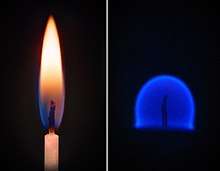
Weightlessness can cause serious problems on technical instruments, especially those consisting of many mobile parts. Physical processes that depend on the weight of a body (like convection, cooking water or burning candles) act differently in free-fall. Cohesion and advection play a bigger role in space. Everyday work like washing or going to the bathroom are not possible without adaptation. To use toilets in space, like the one on the International Space Station, astronauts have to fasten themselves to the seat. A fan creates suction so that the waste is pushed away. Drinking is aided with a straw or from tubes.
See also
Notes
- Note: Accelerometers can detect a sudden change to free fall (as when a device is dropped), but they do this by measuring the change of acceleration from some value to zero. An accelerometer using a single weight or vibrating element and not measuring gradients across distances inside the accelerometer (which could be used to detect microgravity or tidal forces), cannot tell the difference between free fall in a gravity field, and weightlessness due to being far from masses and sources of gravitation. This is due to Einstein's strong equivalence principle.
References
- Oberg, James (May 1993). "Space myths and misconceptions". Omni. 15 (7). Archived from the original on 2007-09-27. Retrieved 2007-05-02.
- Reduced Gravity Research Program
- "Loading..." www.nasaexplores.com. Retrieved 24 April 2018.
- "Zero-G flying means high stress for an old A310". Flightglobal.com. 2015-03-23. Archived from the original on 2017-08-21. Retrieved 2017-08-23.
- "Novespace: microgravity, airborne missions". www.novespace.com. Archived from the original on 31 March 2018. Retrieved 24 April 2018.
- European Space Agency. "Parabolic Flight Campaigns". ESA Human Spaceflight web site. Archived from the original on 2012-05-26. Retrieved 2011-10-28.
- European Space Agency. "A300 Zero-G". ESA Human Spaceflight web site. Retrieved 2006-11-12.
- European Space Agency. "Next campaign". ESA Human Spaceflight web site. Retrieved 2006-11-12.
- European Space Agency. "Campaign Organisation". ESA Human Spaceflight web site. Retrieved 2006-11-12.
- "French astronaut performs "Moonwalk" on parabolic flight - Air & Cosmos - International". Air & Cosmos - International. Archived from the original on 2017-08-21. Retrieved 2017-08-23.
- "Tom Cruise defies gravity in Novespace ZERO-G A310". Archived from the original on 2017-08-21. Retrieved 2017-08-23.
- "Marshall Space Flight Center Drop Tube Facility". nasa.gov. Retrieved 24 April 2018.
- Chang, Kenneth (27 January 2014). "Beings Not Made for Space". New York Times. Archived from the original on 28 January 2014. Retrieved 27 January 2014.
- Kanas, Nick; Manzey, Dietrich (2008), "Basic Issues of Human Adaptation to Space Flight", Space Psychology and Psychiatry, Space Technology Library, 22: 15–48, Bibcode:2008spp..book.....K, doi:10.1007/978-1-4020-6770-9_2, ISBN 978-1-4020-6769-3
- "Archived copy" (PDF). Archived (PDF) from the original on 2012-04-06. Retrieved 2012-05-10.CS1 maint: archived copy as title (link), pg 35, Johnson Space Center Oral History Project, interview with Dr. Robert Stevenson:
"Jake Garn was sick, was pretty sick. I don't know whether we should tell stories like that. But anyway, Jake Garn, he has made a mark in the Astronaut Corps because he represents the maximum level of space sickness that anyone can ever attain, and so the mark of being totally sick and totally incompetent is one Garn. Most guys will get maybe to a tenth Garn, if that high. And within the Astronaut Corps, he forever will be remembered by that."
- Kelly, Scott (2017). Endurance: A Year in Space, a Lifetime of Discovery. With Margaret Lazarus Dean. Alfred A. Knopf, a division of Penguin Random House. p. 174. ISBN 9781524731595.
One of the nice things about living in space is that exercise is part of your job ... If I don't exercise six days a week for at least a couple of hours a day, my bones will lose significant mass - 1 percent each month ... Our bodies are smart about getting rid of what's not needed, and my body has started to notice that my bones are not needed in zero gravity. Not having to support our weight, we lose muscle as well.
- "Health Fitness Archived 2012-05-19 at the Wayback Machine", Space Future
- "The Pleasure of Spaceflight Archived 2012-02-21 at the Wayback Machine", Toyohiro Akiyama, Journal of Space Technology and Science, Vol.9 No.1 spring 1993, pp.21-23
- "The Crazy Effects That Space Travel Has on the Human Body". buzzle.com. Retrieved 24 April 2018.
- Mader, T. H.; et al. (2011). "Optic Disc Edema, Globe Flattening, Choroidal Folds, and Hyperopic Shifts Observed in Astronauts after Long-duration Space Flight". Ophthalmology. 118 (10): 2058–2069. doi:10.1016/j.ophtha.2011.06.021. PMID 21849212.
- Puiu, Tibi (November 9, 2011). "Astronauts' vision severely affected during long space missions". zmescience.com. Archived from the original on November 10, 2011. Retrieved February 9, 2012.
- "Video News - CNN". CNN. Archived from the original on 4 February 2009. Retrieved 24 April 2018.
- Space Staff (13 March 2012). "Spaceflight Bad for Astronauts' Vision, Study Suggests". Space.com. Archived from the original on 13 March 2012. Retrieved 14 March 2012.
- Kramer, Larry A.; et al. (13 March 2012). "Orbital and Intracranial Effects of Microgravity: Findings at 3-T MR Imaging". Radiology. 263 (3): 819–827. doi:10.1148/radiol.12111986. PMID 22416248. Retrieved 14 March 2012.
- Fong, MD, Kevin (12 February 2014). "The Strange, Deadly Effects Mars Would Have on Your Body". Wired. Archived from the original on 14 February 2014. Retrieved 12 February 2014.
- Abbasi, Jennifer (20 December 2016). "Do Apollo Astronaut Deaths Shine a Light on Deep Space Radiation and Cardiovascular Disease?". JAMA. 316 (23): 2469. doi:10.1001/jama.2016.12601.
- Cherry, Jonathan D.; Frost, Jeffrey L.; Lemere, Cynthia A.; Williams, Jacqueline P.; Olschowka, John A.; O'Banion, M. Kerry (2012). "Galactic Cosmic Radiation Leads to Cognitive Impairment and Increased Aβ Plaque Accumulation in a Mouse Model of Alzheimer's Disease". PLOS ONE. 7 (12): e53275. Bibcode:2012PLoSO...753275C. doi:10.1371/journal.pone.0053275. PMC 3534034. PMID 23300905.
- Staff (January 1, 2013). "Study Shows that Space Travel is Harmful to the Brain and Could Accelerate Onset of Alzheimer's". SpaceRef. Retrieved January 7, 2013.
- Cowing, Keith (January 3, 2013). "Important Research Results NASA Is Not Talking About (Update)". NASA Watch. Retrieved January 7, 2013.
- Dunn, Marcia (October 29, 2015). "Report: NASA needs better handle on health hazards for Mars". AP News. Archived from the original on October 30, 2015. Retrieved October 30, 2015.
- Staff (October 29, 2015). "NASA's Efforts to Manage Health and Human Performance Risks for Space Exploration (IG-16-003)" (PDF). NASA. Archived (PDF) from the original on October 30, 2015. Retrieved October 29, 2015.
- "Mutant super-cockroaches from space". New Scientist. January 21, 2008. Archived from the original on June 4, 2016.
- "Egg Experiment in Space Prompts Questions". New York Times. 1989-03-31. Archived from the original on 2009-01-21.
- Caspermeyer, Joe (23 September 2007). "Space flight shown to alter ability of bacteria to cause disease". Arizona State University. Archived from the original on 14 September 2017. Retrieved 14 September 2017.
- Kim W, et al. (April 29, 2013). "Spaceflight Promotes Biofilm Formation by Pseudomonas aeruginosa". PLOS ONE. 8 (4): e6237. Bibcode:2013PLoSO...862437K. doi:10.1371/journal.pone.0062437. PMC 3639165. PMID 23658630.
- Dvorsky, George (13 September 2017). "Alarming Study Indicates Why Certain Bacteria Are More Resistant to Drugs in Space". Gizmodo. Archived from the original on 14 September 2017. Retrieved 14 September 2017.
- Dose, K.; Bieger-Dose, A.; Dillmann, R.; Gill, M.; Kerz, O.; Klein, A.; Meinert, H.; Nawroth, T.; Risi, S.; Stridde, C. (1995). "ERA-experiment "space biochemistry"". Advances in Space Research. 16 (8): 119–129. Bibcode:1995AdSpR..16..119D. doi:10.1016/0273-1177(95)00280-R. PMID 11542696.
- Horneck G.; Eschweiler, U.; Reitz, G.; Wehner, J.; Willimek, R.; Strauch, K. (1995). "Biological responses to space: results of the experiment "Exobiological Unit" of ERA on EURECA I". Adv. Space Res. 16 (8): 105–18. Bibcode:1995AdSpR..16..105H. doi:10.1016/0273-1177(95)00279-N. PMID 11542695.
External links
![]()
![]()
- Weightlessness Flight with Zero-Gravity airplane
- Microgravity Centre
- Microgravity Flight with Zero-G aircraft
- maniacworld.com "NASA Reduced Gravity Aircraft", videos of the NASA Reduced Gravity Aircraft and of participants in a flight on that aircraft.
- How Weightlessness Works at HowStuffWorks
- NASA - SpaceResearch - Human Physiology Research and the ISS: Staying Fit Along the Journey
- Zero gravity chair use the concept of weightlessness
- "Why are astronauts weightless?" Video explanation of the fallacy of "zero gravity".
